We occasionally buy seed based treat sticks for George the Dormouse. He hangs from them to eat and can demolish one in a few days.




Click on the thumbnail to view the image
Calamari Pizza revisited |
Story location: Home / images / food_and_drink / |
| 19/Nov/2011 |
We first made a calamari pizza earlier this year but we ate it before I thought of taking a photograph. The sauce was passata, garlic, courgette and chilli which was liquidized then simmered until it had thickened.
The calamari was from Marks & Spencers and was chargrilled in a red pepper dressing. It was topped with lots of grated cheddar and shredded mozzarella.

(Crossposted from the Pizza Blog)
The National Poultry Show was held at Stoneleigh Park. There were lots of different types of chickens, ducks, turkeys and geese on show, as well as some for sale.
It's probably wrong but after a few minutes of looking at lots of different chickens I started to feel hungry and thought "I could really eat a roast chicken".
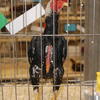



Click on the thumbnail to view the image
Butternut Squash, Chicken and Sweet Potato Curry |
Story location: Home / food_and_drink / |
| 18/Nov/2011 |
The plan was to make a curry with cubes of chicken, sweet potato and butternut squash in a spicy sauce. I started off by making the sauce:
Dice one sweet potato and a similar weight of butternut squash and simmer in a little water for about 5 minutes. Drain and reserve the water.
Chop and fry 1 yellow pepper, half a courgette, 2 cloves of garlic and a chilli pepper until the vegetables have softened. Add 1 teaspoon of curry powder and ½ teaspoon each of powdered ginger and turmeric. Add a few tablespoons of the reserved water from before and a cup of passata then simmer for a few minutes before liquidizing.
Dice and fry 2 chicken breasts then add the squash and sweet potato. Add the vegetable sauce, stir to coat, then simmer for a few minutes. Serve with rice.
The sweet potato had broken down almost to mash, which thickened the sauce much more than I expected. The end result was very nice though. The vegetable sauce was originally a bit too fierce but the thickened sauce had actually absorbed a lot of the spiciness and improved the flavour.
Meat and Halloumi Pasta Bake |
Story location: Home / food_and_drink / |
| 15/Nov/2011 |
Tonight I made a mince and halloumi pasta bake, based on a recipe from the BBC food website. There were two versions of the recipe given, I followed the one by a member of the public instead of the Paul Rankin version, because the sauce contained egg and I thought that might set better. The only changes I made were to use 100g of halloumi in the pasta and sauce, 400g of macaroni, and 340g of mince. This was simply because of the sizes of the packs of meat and cheese, and the amount of pasta left in the pack on our shelf. I also used turkey mince instead of pork mince. It was quite fortunate I used less ingredients because the pyrex tray was very full by the time I layered everything in.
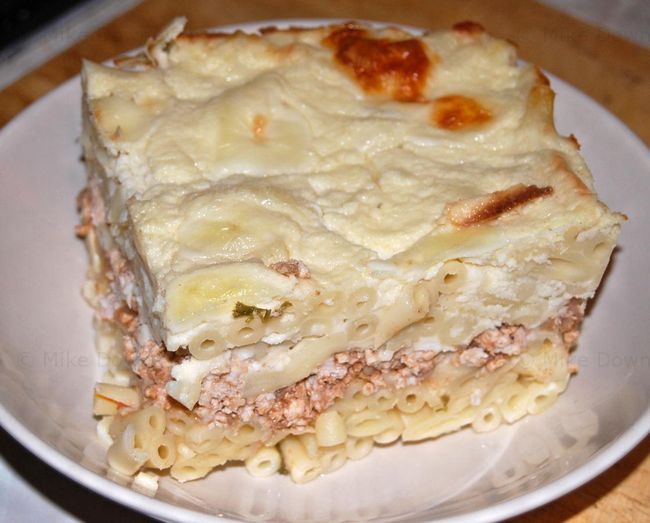
This is the first time I have used halloumi in a recipe, instead of simply slicing and frying it. Overall the pasta bake was very good. I might mix the sauce with the pasta next time so it holds together better for serving but otherwise it went well.
A new junction has recently been installed in the city centre, based on similar ones pioneered in The Netherlands. The traffic lights have been removed from the junction between Jordon Well, Cox Street and Whitfriars Street and the junction has been coloured red:
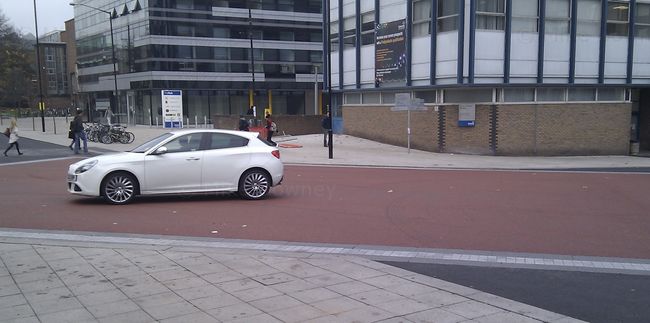
Today was the first time I have been into the city centre since the junction was finished. Apparently the theory is that vehicles and pedestrians all have the same priority as each other and all vehicles need to slow down and navigate the junction with care. Similar schemes have been tried in Europe and they seem to work.
While we were in Asda they did the 2-minute silence over the shop tannoy, and I think everyone stood silently and observed it. It must have been strange for people coming into the shop and finding everyone standing silent and still, but fortunately nobody seemed to be confused by it. The only thing disturbing the silence was the self-checkout machines repeatedly asking for confirmation since the people checking out their shopping had temporarily stopped and the machines were getting confused by it.
Chilli Jam |
Story location: Home / food_and_drink / |
| 08/Nov/2011 |
I still have a few home-grown chillies and tomatoes in the fridge and I felt like making some kind of chilli sauce out of them. A few weeks ago I came across a Chilli Jam recipe from the BBC Good Food website and I thought that might be suitable. I used to occasionally buy a jar of Tracklements chilli jam and the recipe looked like it might give similar results.
I scaled the recipe down a bit for two reasons: I only wanted to make a single jar, and I didn't have enough vinegar or red peppers. The original recipe called for garlic and root ginger, which I didn't have either so I left those out. I hope it doesn't affect the recipe too much.
I started off by weighing 150g of granulated sugar into a pan and added 100ml of white vinegar. I started warming this through gently while I chopped one red pepper and 5 small cayenne peppers and put them in the liquidizer. I peeled 100g of fresh tomatoes, popped those in with the peppers then turned the liquidizer on and blitzed everything to a fine mush. I then added that to the pan.
At this stage, I transferred everything to a small camping stove in the back garden since every time I boil up vinegar in the kitchen, the smell permeates the house and lingers for hours. I gently heated the pan until it started to simmer, then left it for about an hour, stirring occasionally.
When it had started to thicken (and had reached what felt like the consistency of a melted jam) I turned the gas off and let the pan cool slightly while I sterilized a jar by pouring boiling water over it. I emptied the jar, left it to dry for about a minute, then carefully spooned the jam into it.

I haven't tried the jam yet since it is still cooling down so I hope it works out ok.
Last year the Craig Venter Institute announced that they had created an artificial bacterium. I thought I should follow up last months discussion of the Origin of Life with an overview of the claims, even though it is now considered 'old news' now.
Traditionally, genetically modified organisms (GMOs) are created by taking the DNA from an existing organism and identifying the gene responsible for a particular behaviour. In the most widely publicised cases, this has involved taking crop plants and adding genes from other species to add resistance to pesticides or to make the plant create an insect-repelling chemical.
DNA
DNA is a double-stranded molecule which means is consists of two polymers held alongside each other by Hydrogen Bonds, which are bonds between Hydrogen atoms and either Oxygen or Nitrogen atoms and are weaker than those which hold molecules together. The individual units of DNA are the four 'Bases': Adenine, Cytosine, Guanine and Thymine. The two strands of DNA line up with the bases paired off in a specific manner: a Cytosine always bonds with a Guanine and a Thymine always bonds with an Adenine.
A typical bacteria (for example e.coli) DNA contains around 4-5 million of these base pairs (bp) and contains around 4,000 genes. The function of most of these genes is known (or at least suspected), and like parts in a typical machine, some of these genes are essential for survival (such as ones which control essential cell functions) while others appear to be less important and may only be required under unusual circumstances (such as genes which allow bacteria to adapt to different food sources or which change behaviour when toxins are detected). Still more genes appear to serve no useful purpose or may be duplicates of existing genes.
A Less Than Minimal Genome
The goal of the artificial genome project was to create a minimal genome which contained only the essential genes. The e.coli genome is quite large but there are bacteria with much smaller genomes, such as Mycoplasma genitalium. This actually has the smallest genome of any non-symbiotic bacteria at only half a million base pairs and around 520 genes. This was the original target of the experiment and the researchers wanted to determine which of its genes were essential for growth under laboratory conditions. They made mutations where some of the genes had been disrupted but ignored genes where the function was already known to be essential. The bacteria has 480 genes which produce proteins and all but 100 of these appeared to be essential. The functions of some of the essential genes are still unknown.
Unfortunately, m.genitalium grows very slowly so the lessons learned from that were applied to other mycoplasma bacteria. The DNA they finally used was from m.mycoides which has a genome roughly twice the size.
Assembling the Genome
The new artificial genome would contain all of the essential genes without any of those considered to be unnecessary (or at least, not critical for survival in the well defined laboratory conditions). The sequence was split into shorter fragments of around 1000bp and each of these fragments was manufactured from individual bases. These shorter lengths were combined together in a series of steps to ultimately produce the full length DNA. This results in DNA which should contain sufficient genes for a viable cell, but which was made artificially instead of being assembled from fragments obtained from existing cells.
This new DNA also contained some 'watermark' regions to help identify the bacteria as containing the artificial DNA.
The Next Step
The only artificial part of the cell was the DNA, and that was build based on an existing genome, so the cell cannot really be described as truly artificial. It is still a major accomplishment to actually manufacture an entire chromosome since nothing on that scale had been achieved before.
All of the cellular machinery was already in place. Plain DNA on its own is useless and needs to be within a cell before it can perform any functions.
[This is the reason why viruses cannot function outside a cell and need to infect a host in order to replicate - a virus is typically composed of a strand of DNA (or the related RNA) enclosed within a protein shell. The shell is designed to both protect the contents and to help trick its way into a cell. Once inside, the cells DNA replicating machinery is co-opted to manufacture additional copies of the virus]
To make a truly artificial cell, there need to be structures in place to manufacture proteins from the templates present in the DNA (using processes called Transcription and Translation). If the cell is to be able to reproduce then there needs to be a method of duplicating the DNA and partitioning the new DNA and any important proteins and cellular machinery into two halves of the cell before it splits. All of this is complicated and not fully understood.
A truly artificial genome would also need to be written 'from scratch' instead of being assembled from pre-existing components. This is also beyond current abilities since we don't understand the functions of all the essential genes.
In summary, we are still a long way from being able to manufacture life from first principles. At the moment, nearly all of the stages currently require borrowing parts of existing cells. Back in the 18th century, it was generally believed that 'Organic' chemicals based around carbon chains could only be produced by living organisms, hence the name. At the moment we are still at that stage regarding living cells. The hurdles to artificial life are much greater than those to manufacturing chemicals but eventually they will be solved one at a time. It may take decades or even hundreds of years, but it is likely to be cracked eventually.
References
Essential genes of a minimal bacterium, Glass et.al, PNAS, 10 January 2006, vol. 103, no. 2, pp425-430
Creation of a Bacterial Cell Controlled by a Chemically Synthesized Genome, Gibson et.al, Science, vol. 329, 2 July 2010
Kale and Butternut Squash Gnocchi |
Story location: Home / food_and_drink / |
| 05/Nov/2011 |
Last week Nigel gave us a bag of fresh kale. We used half of it in a Kale and Rocket Pesto, which was based on our Kale Pesto recipe. Today I used the rest of the kale to make gnocchi. I took inspiration from a Pumpkin and Rocket Gnocchi recipe in the Covent Garden Soup and Beyond book.
Start by dicing 200g of squash then boil for about 5 minutes until it softens. Take a good sized handful of Kale and cut the stalks from leaves. Drop the kale in the boiling water for a few seconds until it wilts.
Mash the squash and stir in about 70g of plain flour. Chop the kale and stir it in. Some parsley and watercress can also be chopped and added as well. Grate about 60g of cheddar and mix that in too, along with a pinch of salt and a beaten egg.
If the mixture is a bit sloppy, you might need to add a bit more flour. Put dollops of the mixture on a well floured surface and roll into a sausage. Break off bits and roll into balls.
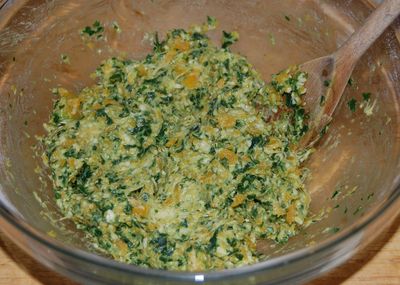
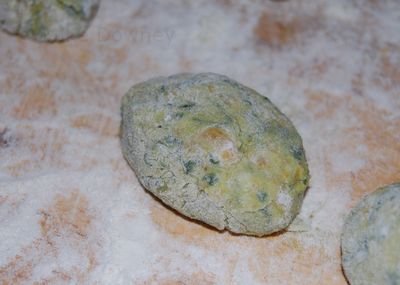
Add the gnocchi to a large pan of simmering water and wait until they float. Serve with a sauce of your choice.
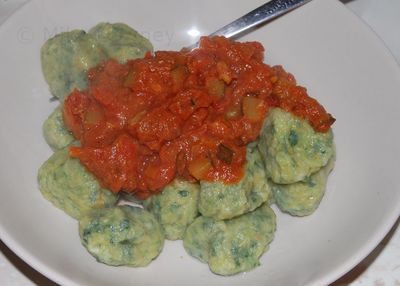
The final picture above has the gnocchi with a tomato and vegetable sauce made by finely chopping some red pepper, a chilli pepper, courgette, leek and garlic and simmering in passata with some added herbs and seasoning for about 15 minutes or so.
